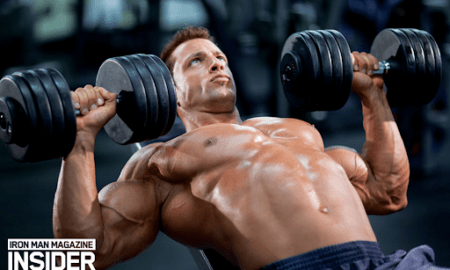Q: I’m 52, and I started working out with weights 12 years ago. I’ve made good progress in most areas, but I have struggled to make my upper-pectoral muscles thicker. No matter what exercise I do for my upper chest, it doesn’t grow. Why don’t Incline movements work for me?
A: I’ve had that problem myself. To make improvements requires specialized, biomechanically sound training. I don’t agree with most experts, who say that training the upper-pectoral region requires lots of incline-bench presses and incline flyes. Let me explain.
First, you probably don’t have a lot of muscle tissue in that area, which is genetic; however, you still can make gains there. Your lower pectorals, a.k.a. the pectoralis major, are probably responding to most of your chest exercises. That has to do with autonomic muscle engagement. Your body is doing that automatically because of your genetic deficiency. The person with ideal biomechanics, of whom there are very few, can isolate the pectorals the way the experts suggest—flat-bench presses for the entire chest, incline presses for the upper pecs and declines for the very lowest area. What if I told you to do the exact opposite?
First, take off your shirt, turn sideways, and look in a mirror. Notice where your deltoids sit. Are they forward of the center of your neck and ear? Now, take note of the front deltoid and your upper pectorals. Are your shoulders forward of your upper chest? My guess is yes on both counts.
Why is that important? That says your deltoids will grow before your upper pecs if you follow the standard rules of pec development. Even if you puff your chest up, arching your back, when doing inclines, your shoulders will still take too much of a load because your deltoids are positioned forward of the center of your neck and will be worked more than your upper chest.
What has happened here involves a lot of musculoskeletal changes. You have gotten a little bit taken by the weak upper-pectoral problem and you have made your upper thorax move enough to make the shoulders change position. Your body may seem like a static group of bones held together with some magical glue; however, each time that you emphasize one muscle group more than the opposing muscle group, you may change the arrangement of the musculoskeletal structure.
My recommendations: First, start doing more center-back work in order to pull your shoulders back enough for them to be in that imaginary straight line from the center of the deltoid to the center of the ear when you’re standing erect. Do low-pulley rows with a bar that allows for maximum squeezing of the shoulder blades. You might want to do a couple of sets of those every other day until you get your shoulders back where they belong.
The other two biomechanical presets I’m assuming are that you have a) rather long arms and b) narrow or medium width across your collarbones. Since your arms are long, you are at a leverage disadvantage in doing almost any pressing but especially when doing inclines as your primary resistance work for upper pecs. Add those two disadvantages to the small amount of muscle fiber in your upper chest, and you are never going to create hypertrophy in that area until you eliminate at least two of the problems.
The first answer to your problem is going to be decline presses. Why? Because they put you in a position that will shorten the overall pressing range and take your front deltoids out of the work. It also allows you to use more weight
After one warmup set with a light weight on the bar, do two to three heavy sets of six to eight repetitions with a barbell. Then do two to three sets of 10 to 12 reps the same way with the heaviest dumbbells you can handle. You may want to alternate which of those you do first.
When you can do no more full reps, do X Reps—extended reps—by moving the bar or dumbbells a few inches up and down in the lower part of the stroke until failure.
For a finishing exercise, use machine flyes. Find a machine that has handles and long arms. Set the seat fairly low so that when you are doing the exercise, your arms are at the exact height of your clavicles—right straight across your upper chest. There should be one continuous line from either side of the upper-pectoral area out to both arms and hands so that when you are in a fully contracted position, it should look like a big-tree hug from the top view. Keep your chest up throughout the exercise. Use as much weight as you can and really squeeze your chest on each contraction. Do three or four sets to absolute failure.
Your upper-pectoral area will begin to grow within three months on this routine. Train your chest no more than twice in eight or nine days and always keep your mental focus to provoke muscular stimulation and hypertrophy.
Also, remember to work on getting your shoulders back to where they belong—in line with the traps, neck and ear. That’s important for both your overall upper-thoracic health and your upper-chest development. IM
Editor’s note: To contact Paul Burke, write to [email protected]. Burke has a master’s degree in integrated studies from Cambridge College in Cambridge, Massachusetts. He’s been a champion bodybuilder and arm wrestler, and he’s considered a leader in the field of over-40 fitness training. You can purchase his book, Burke’s Law—a New Fitness Paradigm for the Mature Male, from Home Gym Warehouse. Call (800) 447-0008, or visit www.Home-Gym.com. His “Burke’s Law” training DVD is also now available.




















You must be logged in to post a comment Login